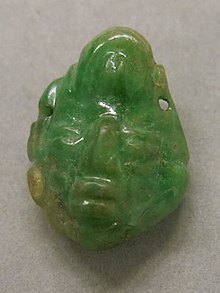


The use of jade in Mesoamerica for symbolic and ideological ritual was highly influenced by its rarity and value among pre-Columbian Mesoamerican cultures, such as the Olmec, the Maya, and the various groups in the Valley of Mexico. Although jade artifacts have been created and prized by many Mesoamerican peoples, the Motagua River valley in Guatemala was previously thought to be the sole source of jadeite in the region.
This extreme durability makes fine grained or fibrous jadeite and nephrite highly useful for Mesoamerican technology. It was often worked or carved as ornamental stones, a medium upon which glyphs[1] were inscribed, or shaped into figurines, weapons, and other objects. Many jade artifacts crafted by later Mesoamerican civilizations appear cut from simple jade axes, implying that the earliest jadeite trade was based in utilitarian function.
